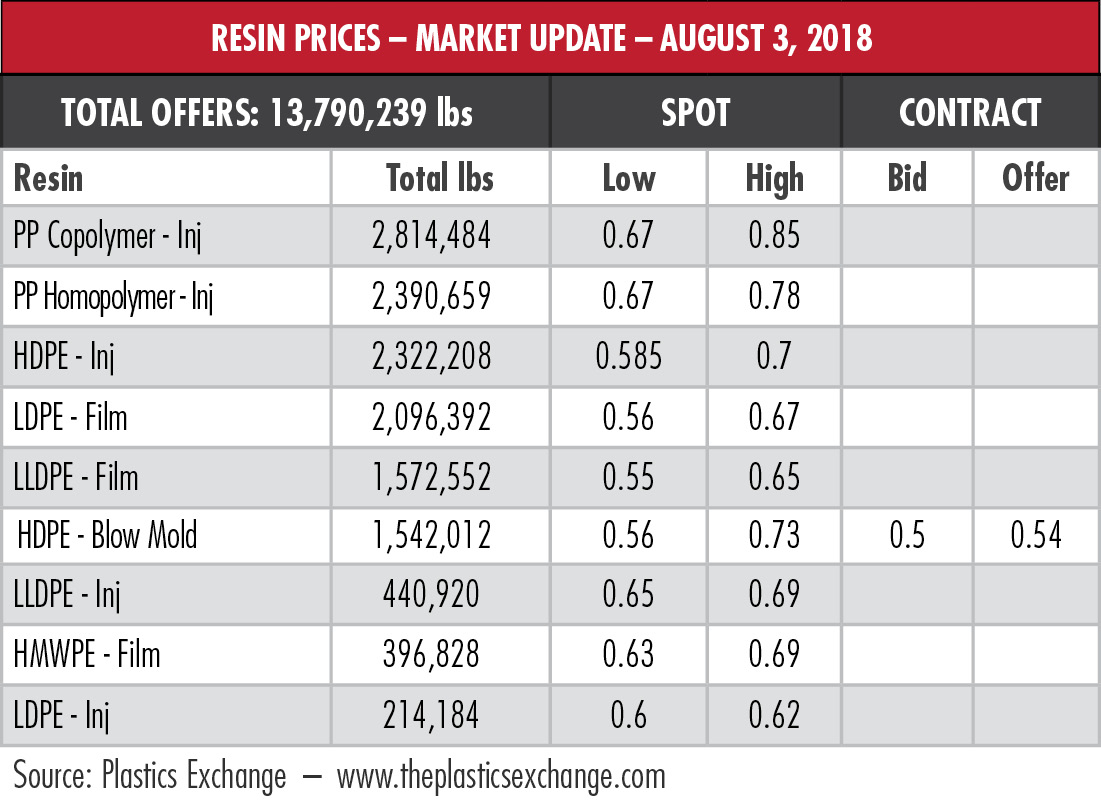
Propane jumped 6.3% in the past week to its highest point since the start of the year and the hypothetical NGL barrel at Mont Belvieu, Texas, closed in on $37 to reach a 195-week—count ’em, that’s 195 weeks—high.
The outlook for ethane, however, appears to be placing a dark cloud inside that silver lining.
 NGL are coming out of July as hot as the summer temperatures. Mont Belvieu’s NGL barrel was up $1.54 or 4.5% over June, and the barrel at Conway, Kan., had a similar percentage rise, clearing $26. Comparisons to July 2017 diverge even more. Mont Belvieu’s barrel is up 44.4% in the last year and Conway’s rise is 10.2%.
NGL are coming out of July as hot as the summer temperatures. Mont Belvieu’s NGL barrel was up $1.54 or 4.5% over June, and the barrel at Conway, Kan., had a similar percentage rise, clearing $26. Comparisons to July 2017 diverge even more. Mont Belvieu’s barrel is up 44.4% in the last year and Conway’s rise is 10.2%.
The contrast stuns even more profoundly when the numbers are from 2016, when barrel prices from both hubs were below $20. This year’s July barrel at Mont Belvieu overwhelmed the July price from the year of investing dangerously by 81%. Conway’s barrel boasts a more modest 42% advantage.
Conway’s margin on the July hypothetical barrel widened by 4.2% from 2017 to 2018. Mont Belvieu’s expanded from $16.59 to $26.42.
The happy totals for July extended to all NGL except isobutane, which took a 10.6% hit from its average June price at Mont Belvieu and a 14.2% drop-off at Conway.
The price of ethane, however, stumbled for the third straight week at Mont Belvieu to a six-week low with its margin narrowing by just over 4% in the last week.
The outlook for ethane could be of concern. ESAI Energy LLC has a decidedly less optimistic approach than many observers to demand growth and pricing in its “Global NGL Five Year Outlook.”
“Announced projects include a potential 58 million tons of ethylene capacity, far more than global ethylene demand can plausibly grow,” ESAI said in a news release. “However, a closer look at what will pan out leads to the unmistakable conclusion that feedstock demand growth and pricing will be less bullish than many believe.”
 What troubles ESAI’s analysts is the ongoing friction between the U.S. and China over trade. On Aug. 1, the Trump administration said it was considering raising tariffs on $200 billion of Chinese goods to 25% from 10%.
What troubles ESAI’s analysts is the ongoing friction between the U.S. and China over trade. On Aug. 1, the Trump administration said it was considering raising tariffs on $200 billion of Chinese goods to 25% from 10%.
At risk, ESAI believes, are four announced ethane crackers in China that would be fed by as much as 450,000 barrels per day of imported U.S. ethane within five years. Escalating the trade dispute between the two countries is likely to make investors nervous and re-evaluate their plans.
The analysts believe the trade issues will be resolved but even short-term tariffs on U.S. ethane, as China has threatened to implement, will slow progress on the projects.
 Andrew Reed, ESAI’s head of NGL, noted that there is a point where the facilities shift from representing increased demand to being indicators of overcapacity.
Andrew Reed, ESAI’s head of NGL, noted that there is a point where the facilities shift from representing increased demand to being indicators of overcapacity.
“For future NGL and naphtha,” he wrote, “the unmistakable conclusion is that overcapacity will lead to greater inter-fuel competition, which the outlooks for demand and pricing of individual feedstocks less bullish that what many believe.”
In the week ended July 20, storage of natural gas in the Lower 48 experienced an increase of 35 billion cubic feet, the U.S. Energy Information Administration reported. The figure, below the Bloomberg survey’s median of 43 Bcf, resulted in a total of 2.308 trillion cubic feet (Tcf). That is 23% below the 2.996 Tcf figure at the same time in 2017 and 19.7% below the five-year average of 2.873 Tcf.
Joseph Markman can be reached at jmarkman@hartenergy.com or @JHMarkman.
Recommended Reading
CEO: Berry Gears Up for Horizontal Drilling in Uinta Stacked Pay
2024-12-13 - Berry Corp.’s legacy roots are in California’s Central Valley—but its growth engine is in Utah’s emerging Uinta Basin, CEO Fernando Araujo told Hart Energy.
Anschutz Explores Utah Mancos Shale Near Red-Hot Uinta Basin
2024-12-10 - Outside of the Uinta Basin’s core oil play, private E&P Anschutz Exploration is wildcatting in Utah’s deeper, liquids-rich Mancos shale bench, according to a Hart Energy analysis.
Shale Outlook Permian: The Once and Future King Keeps Delivering
2025-01-11 - The Permian Basin’s core is in full-scale manufacturing mode, with smaller intrepid operators pushing the basin’s boundaries further and deeper.
CEO: Ovintiv Passes on Permian Prices for More Montney Condensate
2024-11-14 - Rumored to be a potential buyer in the Permian Basin, Ovintiv instead struck a deal for lower-cost oil and condensate assets in Alberta’s Montney Shale.
Jefferies: With Permian Locked Up, E&Ps Hunt for New L48 Runway
2024-11-26 - With the core of the Permian Basin largely locked up, “intrepid operators” are hunting for runway in more nascent Lower 48 basins and in less developed Permian benches.
Comments
Add new comment
This conversation is moderated according to Hart Energy community rules. Please read the rules before joining the discussion. If you’re experiencing any technical problems, please contact our customer care team.






